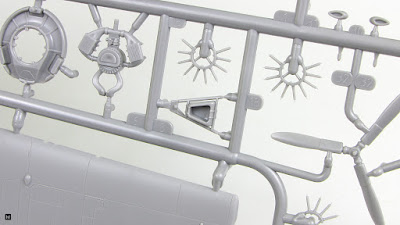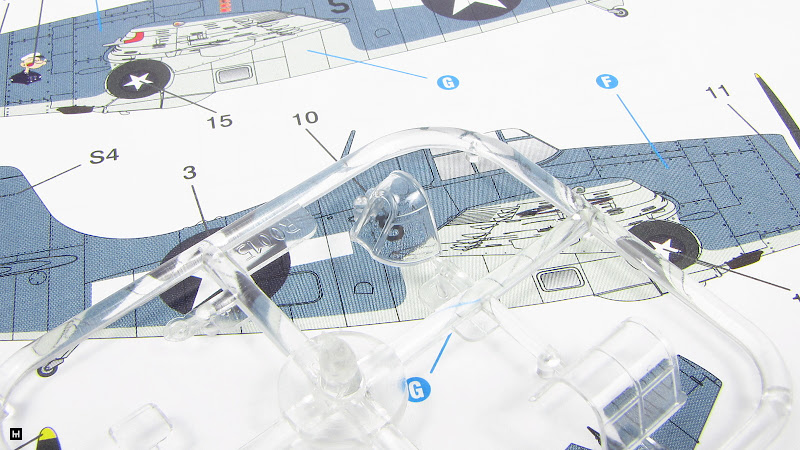F4F-4 Wildcat Model Kit

Yet another Wildcat from Arma Hobby. Except this time it isn’t a new miniature of the next F4F version, but just a second edition of the F4F-4 kit, released not so long ago. Let's have a look.
Disclaimer
The review sample was kindly provided by the manufacturer. Thanks, Arma Hobby.
Overview
One quick glance at the box marked 70048 and it is immediately clear that we are dealing with a product from the "Model Kit" line, i.e. a basic set without (un)necessary (depending on your point of view) extras such as photo-etched details and masks.
Therefore, inside the packaging you will find only the essentials – two light grey plastic sprues, one transparent, a decal sheet and a manual.
Of course, these are the same plastics as in the "Expert" released not so long ago (see review), hence a good portion of the following review may seem strangely familiar.
In detail
Let’s get down to specifics, starting with the fuselage marked by a grid of fine recessed panel lines. Plus some raised details such as inspection hatches hinges.
The overlapping of panels was not replicated and there is no complete riveting present.
Handful of details on the inner surfaces, but that doesn’t mean that the cockpit was handled poorly. About that later.
Arma Hobby doesn’t use slide moulds technology in the production, so the engine cowling has to be assembled from a couple of pieces.
This also applies to the British variant (Martlet II), which can be built from this kit too – as long as you have the right decals.
The engine unit is an area to which the model designer has paid particular attention. Miniature Pratt & Whitney R-1830 Twin Wasp has two separate rows of cylinders.
Each complemented by a separate ring with pushrods covers.
Plus carburettor intake pipes for the rear.
And two front covers versions (Wildcat/Martlet).
Quite nice already, but that’s not all. Assembled engine goes on the firewall.
On the other side of which another piece is mounted, with the radiators (and some small sinkholes).
Then there’s the part with the starter.
And some engine frame fragments.
Including oil reservoir on the upper one.
Wrapping up the subject of propulsion, we should also mention the exhausts.
And three-bladed propeller.
Which can be topped in one of two ways (Wildcat/Martlet)
Now to the wings. Surface details looks similar to the fuselage – thin engraved panel lines and a handful of recessed and raised details.
Although the latter ones are definitely more numerous on the lower surfaces.
Which are further complemented by radiator covers with quite acceptable edges.
The control surfaces have been quite nicely emphasised, both on the wings and the rudder (note also the tailwheel assembly visible in the following photo).
The same applies to the separate elevator which can be tilted without any problems.
Of course after installing the horizontal stabilizer in the correct location.
Additional fuel tanks can be installed under the wings, as long as you don’t forget to drill mounting holes in the lower wing halves (don’t worry, the manual reminds you to do this at the appropriate point).
Smaller plastic sprue also contains parts for the cockpit interior. From the main structural elements in the form of a floor and bulkheads.
To the seat and control stick.
Rear bulkhead of the vast main gear bay looks quite nice.
As well as the entire undercarriage assembly, where the main gears…
…complemented by a number of different supports, including the more delicate ones, will create an elaborate module that can be inserted into the model even after the painting.
A plastic template provided by the manufacturer will make it easier to assemble it correctly.
Two versions of main wheels are provided – you will need only one of them.
Similarly with the tailwheel. Only in this case there are three versions on the sprues and only one of them will be used (visible in one of the earlier photos).
Transparencies
One more frame with plastic elements remained to be discussed – the transparent one, known from the earlier Wildcats released by AH. Windshield and the sliding part of the canopy have been designed as a separate parts, so it is possible to have an open cabin straight from the box.
Both parts of some quite decent thickness and transparency.
There are also F4F-4's distinctive underside windows present here.
Pity that the transparencies were not protected in any way, but simply thrown into the same bag as the other sprues. Fortunately there were no scratches this time.
Decals
The marking sheet included in this edition is not exactly stunning in terms of size. However, it is difficult to have any sensible complaints about it.
The print is clear, the colours are saturated and uniform. No layers offsets or any other defects.
In addition to external markings, there are also stickers for the interior, such as the instrument panel.
Engine nameplates are included here as well, which is great.
Due to the lack of photo-etched parts, pilot’s seatbelts in form of decals are the only option available straight from the box.
I should also mention that Techmod was responsible for the print, which probably won't surprise anyone familiar with Arma Hobby kits.
Manual
Printed on glossy paper, the brochure is designed in the manufacturer’s typical style.
Additional views, renderings and comments appearing here and there should help at critical moments or remind you of important actions during construction.
The list of suggested paints includes numbers from Hataka (Orange Line), AK Interactive (Real Colors), Lifecolor, AMMO, Humbrol, Vallejo and Tamiya palettes.
As usual, the paint schemes have been prepared in colour and also include information about decals placement.
Overall a standard to which we have become accustomed by Arma Hobby.
Painting options
Sets from the "Model Kit" line differ from the "Experts" not only by the lack of any extras, but also by a limited range of paint schemes - there are only two in this kit. F4F-4 from the VMF-111 squadron (pilot: Sam Folsom, Western Samoa, Spring 1943).
And Wildcat from VF-11 Sundowners squadron (Henderson Field, Guadalcanal 1943).
A bit monotonous, but the subject matter doesn't allow for too much.
Summary
The release of the basic F4F-4 kit will surely please many modellers who do not enjoy fiddling with PE parts. They had to wait a bit, but in return get a pretty good model, which even without additional details is a solid base for building 1:72 scale Wildcat.




















































